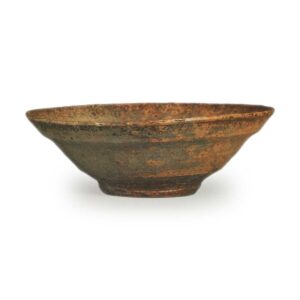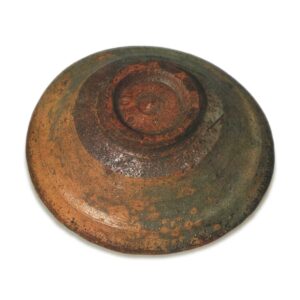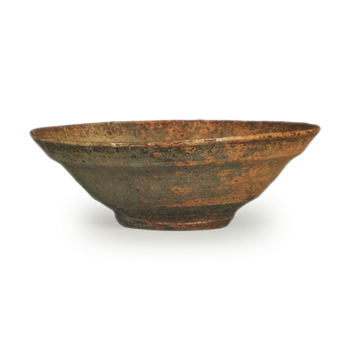

Height: 4.8 – 5.0 cm
Diameter: 14.0 – 14.5 cm
Foot diameter: 5.5 cm
Height: 0.6 cm
The “Taisho Meiki Kan” (A Guide to Famous Tea Bowls from the Taisho Period) states that “Lord Matsudaira Fumai named this tea bowl after the scenery of the Hiroshima area, as it reminded him of the scenery there”. As it is said that Fumai appreciated the rich scenery, it is not an exaggeration to say that this is the best tea bowl of its kind, among the so-called totoya and hei tea bowls. This is a small, thinly made flat bowl with a foot ring that is quite large in comparison to the diameter of the bowl, and is overall low, but it is clearly carved in the shape of a bamboo joint. There are slightly deep grooves around the foot ring, and the carving on the side of the foot ring is particularly well-spaced, giving the entire bottom of the bowl a more refined appearance. From the waist to the rim, the fine lathe marks are shallowly open, but there is a deep constriction around the rim, which gives the body a neat tightness.
The foot ring is slightly thin, and the tatami mat has been smoothly scraped out. There must have been about nine marks on the tatami mat, but only three remain clearly.
The rich reddish glaze on the inside of the footring changes completely to a sober bluish-green tinged with grayish green at the footring rim, and the outer body to the rim changes to a combination of reddish and bluish colors due to firing, with yellowish tones added to the reddish areas and speckled patterns resembling deer spots scattered across the bluish areas. On the inside of the upper part, the whorl marks of the potter’s wheel stand out beautifully from the center to the sides, and there are cracks and stone spalls in the tea pool. The glaze in this area is a strong, pinkish red, and there are nine small marks left on it. The inside is the same as the outside, with a pattern of small spots, but the large and small spots are even more clearly visible.
As with most pottery, the glaze is thin overall, and the clay contains a lot of iron, making it sticky. This tea bowl has many highlights both inside and out, but in particular, the gentle, even turning and scraping of the wheel marks from the foot to the middle of the bowl is one of the best among the tea bowls made by the potter, and the softness of the glaze is also sufficient, making it highly valued as a wabi-style tea bowl.
On the lid of the inner box, which is made of paulownia wood and black persimmon wood, the words “Koryo Tōya” are written in black ink on the paulownia wood, and the two characters “chawan” (tea bowl) are written in gold powder on the black persimmon wood. The calligrapher is Matsudaira Fumai.
According to the accompanying letter, “The Origin of the Toto-ya Hira Tea Bowl, which was in the same box as the secret treasure of Lord Fumai”, the tea bowl was made in the first year of the Meiji era, in the month of January, in the year of the dog, before and after the battle of Toba-Fushimi, when the world was in chaos and the various clans were on the lookout for allies, holding both ends of the situation, and waiting to see how things would turn out. In this situation, the Unshu clan was not exempt from this selection, and as it was difficult to avoid the stigma of being an enemy of the court, it was decided to use the services of a man named Takatsukasa Yamatokami Yamada, a high-ranking official of the Takatsukasa family, to resolve the situation. Therefore, the Unshu family sent a gift to the Udai-no-kami, and as he was a tea ceremony enthusiast and had a particular fondness for rare tea utensils, he requested that the family send him a tea utensil of great value. The tea bowl in question was a tea bowl that had been treasured by the lord of the domain, and was now kept in secret. The passage describes how the tea bowl came to be in the possession of the Matsudaira family. It then came into the possession of the Kyoto tea master, Yamada Kōbei, but in 1900 it passed into the hands of a man in Osaka, and was then owned by the Kyoto dealer Asai Kyūtarō, who used it in the Gion Festival’s annual tea ceremony. It was then passed down to the Fujita family in Osaka, where it remained in their possession until recent years.



